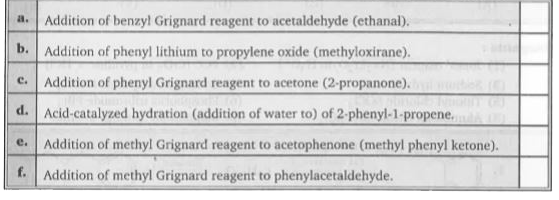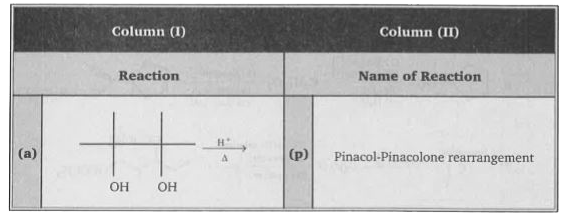Complete Solutions to LEVEL-2 of chapter ALCOHOL,ETHERS AND EPOXIDES of Class 12 book with complete answers and questions
| Class 12 | CHEMISTRY |
| Chapter | ALCOHOL,ETHERS AND EPOXIDES |
| MS CHOUHAN | LEVEL-2 |
| Number Of Questions | 24 |
| Academic Year | 2023-24 |
Consider the pairs ofethers, numbered I throughV, shown below. To the right of each pairis a description of reaction conditions to be applied to each. One compound of the pair will react more rapidly than the other.
Which ether of the two will be more rapidly cleaved?
Write your answer in box.

View Solution
Based on the above isomer answer the following (A to F).
Which isomer is most reactive towards dehydration by conc. `H_2SO_4` ?
View Solution
Based on the above isomer answer the following (A to F).
Which isomer will undergo rearrangement when treated with conc. `H_2SO_4` ?
View Solution
Based on the above isomer answer the following (A to F).
Which isomers on dehydration with conc. `H_2SO_4` give alkene which is capable to show geometrical isomerism ?
View Solution
Based on the above isomer answer the following (A to F).
Which isomer is least acidic ?
View Solution
Based on the above isomer answer the following (A to F).
Which isomers on dehydration give most stable alkene?
View Solution
Based on the above isomer answer the following (A to F).
Which isomer on dehydration with conc. `H_3PO_4` undergo maximum rearrangement?
View Solution
Conversion `(CH_3 - CH_3 rarr CH_3 - CH_2 - OH) " alkane " rarr ` alcohol is ahieved by :
View Solution
Conversion `R -CH_2 - OH rarr R -CHO` can be done by :
View Solution
Conversion `R-CHO rarr R - CO_2 H` can be done by
View Solution
Coversion ` R - CO_2H rarr R - CHO` can be done by :
View Solution
Coversion `R - CHO rarr R - CH_2 -OH` can be done by :
View Solution
Reduction `R - CH_2 - OH rarr R - CH_3` can be done by :
View SolutionWhich of the following is true for 3- methylbutanal ?

View SolutionThis problem is an introduction to the planning of multistep syntheses
For use, you have six reactant compounds (A through F) , and eight reagents (1 through 8), shown below
Following these lists, five multistep syntheses are outlined. For each of these, certain reactants or reagents must be identified by writing an appropriate letter or number in designated answer boxes. Write a single letter or number, indicating your choice ofthe best reactant or reagent, in each answer box.

View SolutionWhich of the following is true for 3- methyl-2-butanone?

View SolutionWhich of these methods would serve to prepare 1-phenyl-2-propanol?

View SolutionMatch the Column (I) and (II) .


View SolutionMatch the Column (I) and (II) .

View Solution
Ratio ofmoles of formaldehyde obtained in the reaction (1) and reaction (2) ?
View SolutionDi-tert-glycols rearrange in the presence of acid to give `alpa`-tertiary ketones. The trivial name of the simplest glycol of this type is pinacol, and this type of reaction therefore is named pinacol rearrangement (in this specific case, the reaction is called a pinacol-pinacolone rearrangement). The rearrangement involves 4 steps. one of the hydroxyl groups is protonated in the first step. A molecule of water is eliminated in the second step and a tertiary carbocation is formed. The carbocation rearranges in the third step into a more stable carboxonium ion via a [1,2] rearrangement. In the last step, the carboxonium ion is deprotonated and the product ketone is obtained.

What is R.D.S. of pinacol-pinacolone rearrangement?
View SolutionDi-tert-glycols rearrange in the presence of acid to give `alpa`-tertiary ketones. The trivial name of the simplest glycol of this type is pinacol, and this type of reaction therefore is named pinacol rearrangement (in this specific case, the reaction is called a pinacol-pinacolone rearrangement). The rearrangement involves 4 steps. one of the hydroxyl groups is protonated in the first step. A molecule of water is eliminated in the second step and a tertiary carbocation is formed. The carbocation rearranges in the third step into a more stable carboxonium ion via a [1,2] rearrangement. In the last step, the carboxonium ion is deprotonated and the product ketone is obtained.


How many products obtained in above reaction?
View SolutionDi-tert-glycols rearrange in the presence of acid to give `alpa`-tertiary ketones. The trivial name of the simplest glycol of this type is pinacol, and this type of reaction therefore is named pinacol rearrangement (in this specific case, the reaction is called a pinacol-pinacolone rearrangement). The rearrangement involves 4 steps. one of the hydroxyl groups is protonated in the first step. A molecule of water is eliminated in the second step and a tertiary carbocation is formed. The carbocation rearranges in the third step into a more stable carboxonium ion via a [1,2] rearrangement. In the last step, the carboxonium ion is deprotonated and the product ketone is obtained.


View SolutionDi-tert-glycols rearrange in the presence of acid to give `alpa`-tertiary ketones. The trivial name of the simplest glycol of this type is pinacol, and this type of reaction therefore is named pinacol rearrangement (in this specific case, the reaction is called a pinacol-pinacolone rearrangement). The rearrangement involves 4 steps. one of the hydroxyl groups is protonated in the first step. A molecule of water is eliminated in the second step and a tertiary carbocation is formed. The carbocation rearranges in the third step into a more stable carboxonium ion via a [1,2] rearrangement. In the last step, the carboxonium ion is deprotonated and the product ketone is obtained.


View Solution
LEVEL-2 questions and complete solutions for chapter ALCOHOL,ETHERS AND EPOXIDES of MS CHOUHAN of Class 12